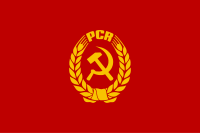General Secretary of the Romanian Communist Party
|
Romanian Communist Party
Partidul Comunist Român |
|
|---|---|
 |
|
| General Secretary (s) |
Gheorghe Cristescu (first) Nicolae Ceaușescu (last) |
| Founded | 8 May 1921 |
| Dissolved | 22 December 1989 |
| Headquarters | Bucharest |
| Newspaper | Scînteia |
| Youth wing | Union of Communist Youth |
| Paramilitary wing | Gărzile patriotice |
| Ideology |
Communism Marxism–Leninism National Communism (after 1960) |
| Political position | Far-left |
| European affiliation | Balkan Communist Federation (1921–39) |
| International affiliation |
Comintern (1921–43), Cominform (1947–56) |
| Colours | Red Gold |
| Party flag | |
 |
|
The Romanian Communist Party (Romanian: Partidul Comunist Român, PCR) was a communist party in Romania. Successor to the pro-Bolshevik wing of the Socialist Party of Romania, it gave ideological endorsement to communist revolution and the disestablishment of Greater Romania. The PCR was a minor and illegal grouping for much of the interwar period, and submitted to direct Comintern control. During the 1930s, most of its activists were imprisoned or took refuge in the Soviet Union, which led to the creation of separate and competing factions until the 1950s. The Communist Party emerged as a powerful actor on the Romanian political scene in August 1944, when it became involved in the royal coup that toppled the pro-Nazi government of Ion Antonescu. With support from Soviet occupation forces, the PCR was able to force King Michael I into exile, and establish undisguised Communist rule in 1948. The party operated under the title of The "Romanian workers party" from 1954 until 1965 when it was officially renamed by Nicole Ceaușescu who had just been elected secretary general. From then until 1989, it was for all intents and purposes the only legally permitted party in the country.
In 1947, the Communist Party absorbed much of the Social Democratic Party, while attracting various new members. In the early 1950s, the PCR's dominant wing around Gheorghe Gheorghiu-Dej, with support from Joseph Stalin, defeated all the other factions and achieved full control over the party and country. After 1953, the Romanian Communists gradually theorized a "national path" to Communism. At the same time, however, the party did not join its Warsaw Pact brethren in de-Stalinization. The PCR's nationalist and national communist stance was continued under the leadership of Nicolae Ceaușescu. Following an episode of liberalization in the late 1960s, Ceaușescu again adopted a hard line, and imposed the "July Theses", radicalising the party's rule by intensifying the spreading of Marxist Leninist thought in Romanian society and at the same time consolidating Ceaușescu's grip on power. Over the years, the PCR massively and artificially increased in size, becoming entirely submitted to Ceaușescu's will. From the 1960s onward, it had a reputation for being somewhat more independent of the Soviet Union than its brethren in the Warsaw Pact. However, at the same time it became one of the most (and according to some accounts, the most) hardline parties in the Soviet bloc. It collapsed in 1989 in the wake of the Romanian Revolution.
...
Wikipedia
